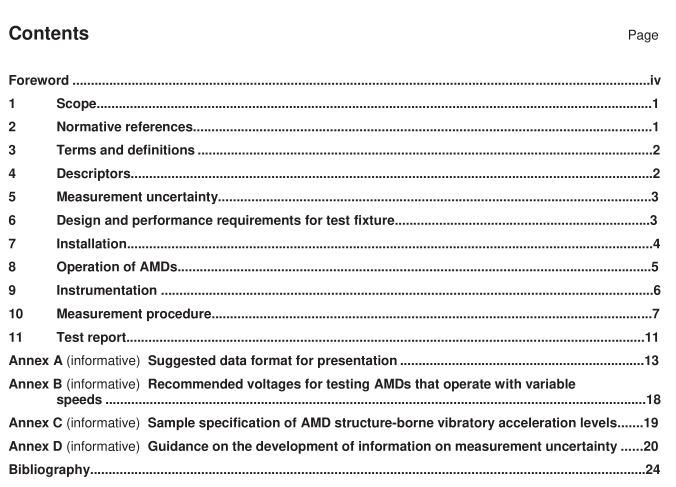BS ISO 10302-2 pdf download

BS ISO 10302-2 pdf download Acoustics — Measurement of airborne noise emitted and structure-borne vibration induced by small air-moving devices Part 2: Structure-borne vibration measurements
6.1.3 Static pressure The static pressure of the AMD operating on the plenum should be no greater than 750 Pa.
6.1.4 Air/pressure distribution All relative geometries (such as locations and proportions of the mounting panel or the exit port) shall be the same as those of the full-size plenum of ISO 1 0302-1 .
6.2 Damped panel The specification on the plate stock is a mechanical mobility level (reference: 1 m/N s) of −45 dB from 25 Hz to 5 000 Hz when measured in the middle of a panel of dimensions 1 ,0 m 2 with no fan-mounting hole and with the panel freely suspended by two corners. The mobility level measurement should be made in accordance with ANSI/ASA S2.32 [1 7] . The tolerance on the mobility levels is ±8 dB from 25 Hz to 1 00 Hz, ±4 dB from 1 00 Hz to 200 Hz, and ±2 dB from 200 Hz to 5 000 Hz. These tolerance limits ensure that the panel has sufficient damping to prevent excitation of the frame 1 ) .
6.3 Mounting area This part of ISO 1 0302 covers vibration levels from small AMDs with a maximum mounting footprint of up to 0,48 m × 0,90 m for the full-size plenum. For all sizes of plenum, the distances from the edges of the AMD maximum mounting footprint to the edges of the damped panel are constant: 0,06 m from the top and bottom and 0,1 5 m from the sides. (Thus for a half-sized plenum, this part of ISO 1 0302 covers AMDs with a maximum mounting footprint of up to 0,1 8 m × 0,30 m.)
7 Installation
7.1 Orientation of the AMD The discharge side of the AMD shall be mounted on the damped panel if this is an available mounting option. If other mounting options are used, they shall be reported.
7.2 Mounting of the AMD The AMD shall be mounted on a damped panel meeting the specifications of 6.2. Unless special mounting attachment devices are being evaluated, the AMD shall be attached to the damped panel with through-screws, as specified by the AMD manufacturer. The screws shall be tightened to the torque specified by the AMD manufacturer. In the absence of manufacturers’ specifications, M3.5 (UNC 6-32) through-screws are recommended, tightened to 0,34 m. In the case of multiple in-line mounting holes being provided in the AMD housing, only the holes against or nearest the damped panel assembly shall be used.
7.3Damped panel opening
The plenum opening for air to exit or enter the AMD shall be as specified by the manufacturer. In the absenceof manufacturers’ specifications, the opening shall be at least as large as the corresponding discharge or inletof the AMD, smooth and free of burrs. The AMD shall be mounted on the damped panel assembly directly andwithout any seals or gasketing.
8Operation of AMDs8.1Input power
8.1.1 Alternating current AMDs
Unless otherwise specified, the AMD shall be operated at each rated power line frequency and within ±1 % ofeither:
a)the rated AMD voltage (if any is stated); orb)the mean voltage of the stated range.
For power having more than two phases, the phase-to-phase voltage variation shall not exceed 1 % of therated voltage.The voltage condition used shall be recorded.
8.1.2 Direct current AMDs
The AMD shall be operated within ±1 % of each of the following supply voltages:a)rated nominal voltage;
b)rated maximum voltage;c)rated minimum voltage.
Additionally recommended, but not required,voltages are given in Annex B if the fan operates with variablespeeds. lIn this case, the voltage condition used shall be recorded.
8.2Points of operation
Unless otherwise specified, the AMD shall be tested at three points of operation for each of the requiredfrequencies and voltages given in 8.1.These points of operation correspond to:
a) the adjustable exit port (slider) completely open;
b)80 % of maximum volume flow rate;
c)20 % of maximum volume flow rate.









